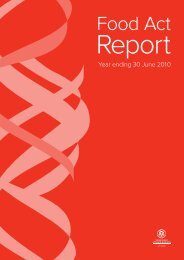Public Health and Communicable Diseases - SA Health - SA.Gov.au
Public Health and Communicable Diseases - SA Health - SA.Gov.au
Public Health and Communicable Diseases - SA Health - SA.Gov.au
Create successful ePaper yourself
Turn your PDF publications into a flip-book with our unique Google optimized e-Paper software.
living conditions <strong>and</strong> health status among AboriginalAustralians. The approach to kidney <strong>and</strong> cardiovasculardisease prevention among Aboriginal people needs to bebroad-based, <strong>and</strong> extend beyond traditional risk-factorsto include consideration of infections both as a directpathologic c<strong>au</strong>se, <strong>and</strong> more importantly of repeatedexposure to bacterial infection as a marker of a high-riskenvironment. A logical outcome of this is a broadeningof risk-factor modification approaches at both anindividual <strong>and</strong> community level.Finally, this area is an example of the value of diseaseregistries. Although ESKD is a relatively rare disease, thedocumentation <strong>and</strong> subsequent efforts to address thehigh rates of kidney disease among Aboriginal peoplebegan with the reporting of high rates of ESKD, <strong>and</strong> theepidemiology of ESKD has been an important basis forthe investigation in this area.Further readingThe themes in this brief review are further developed in36, 42, 45-47several manuscripts.References1. Hoy WE, Norman RJ, Hayhurst BG, et al. A healthprofile of adults in a Northern Territory Aboriginalcommunity, with an emphasis on preventablemorbidities. Aust N Z J <strong>Public</strong> <strong>Health</strong>. 1997;21:121-126.2. McDonald SP, Maguire GP, Hoy WE. Renal function<strong>and</strong> cardiovascular risk markers in a remote AustralianAboriginal community. Nephrol Dial Transplant.2003;18:1555-1561.3. Eiser D. Microalbuminuria <strong>and</strong> cardiovascular riskfactors in Central Australian Aboriginal Communities.In: Department of Medicine, Melbourne, Universityof Melbourne;1995, 73.4. Rowley KG, Iser DM, Best JD, et al. Albuminuriain Australian Aboriginal people: prevalence <strong>and</strong>associations with components of the metabolicsyndrome. Diabetologia. 2000;43:1397-1403.5. Shephard M, James J, Allen G, et al. A preventativemodel for Aboriginal kidney disease. In: Departmentof Renal Medicine (vol 1999), Flinders MedicalCentre, Adelaide; 1999.6. Hoy W, Wang Z, van Buynder P, et al. The naturalhistory of renal disease in Australian Aborigines.Part 2. Albuminuria predicts natural death <strong>and</strong> renalfailure. Kidney Int. 2001;60:249-256.7. McDonald SP, Russ GR. Current incidence, treatmentpatterns <strong>and</strong> outcome of end-stage renal diseaseamong indigenous groups in Australia <strong>and</strong> NewZeal<strong>and</strong>. Nephrology. 2003;8:42-48.148. Trewin D, Madden R. The <strong>Health</strong> <strong>and</strong> Welfare ofAustralia’s Aboriginal <strong>and</strong> Torres Strait Isl<strong>and</strong>erPeoples. ABS Catalogue number 4704.0. In:Australian Bure<strong>au</strong> of Statistics, Canberra; 2005.9. Carapetis JR, Connors C, Yarmirr D, et al. Success ofa scabies control program in an Australian aboriginalcommunity. Pediatr Infect Dis J. 1997;16:494-499.10. Nimmo GR, Tinniswood RD, Nuttall N, et al. Group Astreptococcal infection in an Aboriginal community.Med J Aust. 1992;157:521-522.11. Streeton CL, Hanna JN, Messer RD, et al.An epidemic of acute post-streptococcalglomerulonephritis among aboriginal children. JPaediatr Child <strong>Health</strong>. 1995;31:245-248.12. Van Buynder PG, Gaggin JA, Martin D, et al.Streptococcal infection <strong>and</strong> renal disease markersin Australian aboriginal children. Med J Aust.1992;156:537-540.13. Cunningham J, Condon JR. Premature mortality inAboriginal adults in the Northern Territory, 1979-1991.Med J Aust. 1996;165:309-312.14. Dempsey K, Condon J. Mortality in the NorthernTerritory 1979-1997. 1 ed. Darwin, Territory <strong>Health</strong>Services; 1999.15. Durie MH. The health of indigenous peoples. BMJ.2003;326:510-511.16. Plant A, Condon J, Durling G. Northern Territoryhealth outcomes: morbidity <strong>and</strong> mortality 1979-1991.Darwin, NT Department of <strong>Health</strong> <strong>and</strong> CommunityServices; 1995.17. Bastian P. Coronary heart disease in tribal Aborigines :the West Kimberley survey. Aust N Z J Med.1979;9:284-292.18. Edwards FM, Wise PH, Thomas DW, et al. Bloodpressures <strong>and</strong> electrocardiographic findings inthe South Australian Aborigines. Aust N Z J Med.1976;6:197-205.19. Simons L, Whish P, Marr B, et al. Coronary riskfactors in a rural community which includesAborigines: Inverell Heart Disease PreventionProgramme. Aust N Z J Med. 1981;11:386-390.20. Markey P. The prevalence of ischaemic <strong>and</strong> rheumaticheart disease <strong>and</strong> risk factors in Aboriginal <strong>and</strong> non-Aboriginal footballers. In: Department of CommunityMedicine, Adelaide, University of Adelaide; 1996, 117.21. Sladden T. Cardiovascular disease risk factors inadults of an Aboriginal community. In: MenziesSchool of <strong>Health</strong> Research, Darwin, University ofSydney; 1990, 135.22. Smith RM, Spargo RM, Hunter EM, et al. Prevalenceof hypertension in Kimberley Aborigines <strong>and</strong> itsrelationship to ischaemic heart disease. An agestratifiedr<strong>and</strong>om survey. Med J Aust. 1992;156:557-562.
















